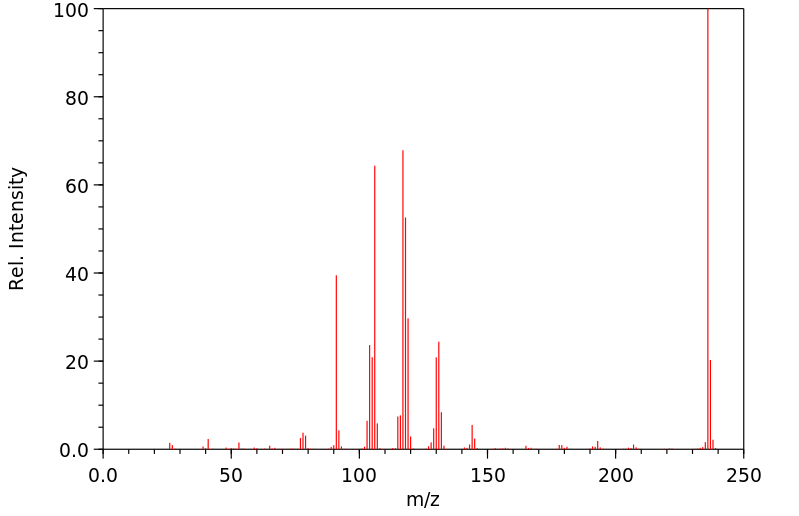三环[10.2.2.25,8]十八碳-5,7,12,14,15,17-六烯 | 2913-24-8
中文名称
三环[10.2.2.25,8]十八碳-5,7,12,14,15,17-六烯
中文别名
——
英文名称
[3.3]paracyclophane
英文别名
<3.3>-Paracyclophan;<3.3>paracyclophane;[3.3]Paracyclophan;tricyclo[10.2.2.25,8]octadeca-1(15),5,7,12(16),13,17-hexaene
CAS
2913-24-8
化学式
C18H20
mdl
——
分子量
236.357
InChiKey
RUVOYPXKKFOGBH-UHFFFAOYSA-N
BEILSTEIN
——
EINECS
——
-
物化性质
-
计算性质
-
ADMET
-
安全信息
-
SDS
-
制备方法与用途
-
上下游信息
-
文献信息
-
表征谱图
-
同类化合物
-
相关功能分类
-
相关结构分类
物化性质
-
熔点:104.5-105.5 °C(Solv: ethanol (64-17-5))
-
沸点:313.82°C (rough estimate)
-
密度:0.9900 (rough estimate)
计算性质
-
辛醇/水分配系数(LogP):5.5
-
重原子数:18
-
可旋转键数:0
-
环数:6.0
-
sp3杂化的碳原子比例:0.33
-
拓扑面积:0
-
氢给体数:0
-
氢受体数:0
SDS
上下游信息
-
上游原料
中文名称 英文名称 CAS号 化学式 分子量 —— [3.3]paracyclophane-2,11-dione 7568-20-9 C18H16O2 264.324 —— 4-(3-phenyl-propyl)-benzoic acid 6337-66-2 C16H16O2 240.302 1,4-双(2-溴乙基)苯 1,4-bis(2-bromoethyl)benzene 4542-72-7 C10H12Br2 292.013 —— 4-[3-(4-acetyl-phenyl)-propyl]-benzoic acid 860693-11-4 C18H18O3 282.339 对二甲苯二聚体 [2.2]Paracyclophan 1633-22-3 C16H16 208.303
反应信息
-
作为反应物:描述:参考文献:名称:Macro rings. XXXIX. Syntheses and spectral properties of the aromatic monosubstituted derivatives of [3.3]paracyclophane摘要:DOI:10.1021/ja01041a019
-
作为产物:描述:1,4-双(2-溴乙基)苯 在 Raney Ni (W-2) sodium tetrahydroborate 、 邻氨基苯甲酸 、 亚硝酸异戊酯 作用下, 以 四氢呋喃 、 乙醇 为溶剂, 反应 34.0h, 生成 三环[10.2.2.25,8]十八碳-5,7,12,14,15,17-六烯参考文献:名称:Diselena[3.3]环烷合成[2.2]环烷的新方法摘要:研究了二硒化物合成环状二硒化物以及通过三种途径进行的脱硒反应。在过量硼氢化钠存在下制备环状二硒化物,得到了 38 种二硒化物,其中含有二硒 [3.3] 环芳烃和脂环式二硒化物,以及两个三桥联硒环芳烃。三(二甲氨基)膦中二硒化物的光脱硒以比其他两种方法(即苯-史蒂文斯重排/雷尼镍氢解和热解脱硒)高得多的产率提供了一系列 [2.2] 环烷。650℃。本研究表明,光脱硒方法与其前体二硒化物的合成相结合,远优于传统的脱硫方法。DOI:10.1246/bcsj.60.4027
文献信息
-
Layered Compounds. LIX. Facile Syntheses and Spectral Properties of [3.3]Cyclophanes and Related Cyclophanes作者:Tetsuo Otsubo、Masashi Kitasawa、Soichi MisumiDOI:10.1246/bcsj.52.1515日期:1979.5of [3.3]cyclophanes via dithia[4.4]cyclophanes is presented. The spectra of a variety of cyclophanes were examined and compared to those of [2.2]analogues. It was concluded from the absorption spectra that the transannular π-π interactions of the cyclophanes were strongly dependent on both ring-to-ring distance and overlapping mode. From the emission spectra, it was described that cyclophanes of parallel
-
Layered Compounds. LXIII. Bromination of Double- and Triple-layered Paracyclophanes作者:Tetsuo Otsubo、Hisanori Horita、Yosuke Koizumi、Soichi MisumiDOI:10.1246/bcsj.53.1677日期:1980.6n]Triple-layered paracyclophanes underwent bromination to give exclusively monobromo derivatives substituted to the inner benzene. The reactions were markedly accelerated by the transannular electronic interaction as compared to [n]- and double-layered paracyclophanes, and their enhanced reactivities were demonstrated by some competitive reactions. The relative rates of [2.2] and [3.3]systems are in reverse
-
Paracyclophanes: Extending the Bridges. Reactions作者:Zissis Pechlivanidis、Henning Hopf、Jörg Grunenberg、Ludger ErnstDOI:10.1002/ejoc.200800748日期:2009.1n]Paracyclophanes with bridges of equal and unequal length (m,n ≤ 4) undergo electrophilic aromatic substitution (Friedel–Crafts acylation, bromination) under very mild conditions as long as the bridge contains less than four atoms. Whenever there is a choice, the aromatic ring is attacked at the position closest to the shorter alkano bridge, which indicates that the transannular benzene moiety acts as[mn]具有等长和不等长桥(m,n ≤ 4)的对环芳烃在非常温和的条件下进行亲电芳香取代(弗里德尔-克拉夫茨酰化,溴化),只要桥包含少于四个原子。每当有选择时,芳环就会在最靠近较短链烷烃桥的位置受到攻击,这表明跨环苯部分充当相邻基团。通过溴化获得的乙酰基衍生物和由其衍生的酸和酯,将第二个取代基引入到假偶合位置,即直接与导向基团相对。然而,这种效应仅在那些相邻桥的长度不超过三个原子的[mn]phanes 中观察到。对于丁醇桥接衍生物,区域选择性完全丧失。对于在一个苯环上带有两个酯取代基的 [mn] 对环芳,观察到非常相似的结果,限制情况是 [4.3] 对环芳衍生物。我们建议取代基的立体控制效应只能在环内距离低于 4 A 时发生。 (© Wiley-VCH Verlag GmbH & Co. KGaA, 69451 Weinheim, Germany, 2009)
-
The first osmium(II), ruthenium(II) and iron(II) complexes of [3 ]cyclophanes (n=2–4): synthesis and electrochemical study作者:Teizi Satou、Ko Takehara、Mihoko Hirakida、Youichi Sakamoto、Hiroyuki Takemura、Hirokazu Miura、Mie Tomonou、Teruo ShinmyozuDOI:10.1016/s0022-328x(98)01025-0日期:1999.37 and 0.1–0.4 ppm for Fe(II) and Ru(II) complexes, respectively, whereas those of Os(II) complexes are ca. −0.2–0.1 ppm. The complexation shifts of the 13C-NMR signals of the tertiary aromatic carbons of the metal-bound benzene ring are ca. 39–42 and 45–50 ppm for Ru(II) and Os(II) complexes, respectively. Thus the 1H- and 13C-NMR chemical shifts of the metal-bound aromatic hydrogens and carbons are(η 6 -C 6 H ^ 6)(η 6 - [3 Ñ ]环芳)钌(II)[BF 4 ] 2和相应的OS(II)[PF 6 ] 2,以及双(η 5 -C 5 ħ 5)(η 6,η 6 - [3 ñ ]环芳)的Fe(II)的Fe(II)[PF 6 ] 2([3 ñ ]环芳= [3 2 ](1,4)环芳2,[3 3 ](1,3,5)Cyclphane 3,[34 ](1,2,3,5)环芳4,[3 4 ](1,2,4,5)环芳5),已经合成和表征。与金属结合的芳族质子(H b)的1 H-NMR信号的络合位移为。Fe(II)和Ru(II)配合物的浓度分别为0.5-0.7和0.1-0.4 ppm,而OS(II)配合物的浓度约为0.5-0.7 ppm。−0.2–0.1 ppm。与金属结合的苯环的叔芳族碳原子的13 C-NMR信号的络合位移为。Ru(II)和OS(II)配合物的浓度分别为39–42和45–50
-
SYNTHESES OF [3.3]CYCLOPHANES作者:Tetsuo Otsubo、Masashi Kitasawa、Soichi MisumiDOI:10.1246/cl.1977.977日期:1977.8.5Two synthetic methods of [3.3]cyclophanes via dithia[4.4]cyclophanes are presented. Direct photodesulfurization method is generally successful except in the cases of metapara- and meta-cyclophanes which are prepared by pyrolytic method of bissulfone.
表征谱图
-
氢谱1HNMR
-
质谱MS
-
碳谱13CNMR
-
红外IR
-
拉曼Raman
-
峰位数据
-
峰位匹配
-
表征信息
同类化合物
(βS)-β-氨基-4-(4-羟基苯氧基)-3,5-二碘苯甲丙醇
(S,S)-邻甲苯基-DIPAMP
(S)-(-)-7'-〔4(S)-(苄基)恶唑-2-基]-7-二(3,5-二-叔丁基苯基)膦基-2,2',3,3'-四氢-1,1-螺二氢茚
(S)-(+)-5,5'',6,6'',7,7'',8,8''-八氢-3,3''-二叔丁基-1,1''-二-2-萘酚,双钾盐
(S)-盐酸沙丁胺醇
(S)-溴烯醇内酯
(S)-7,7-双[(4S)-(苯基)恶唑-2-基)]-2,2,3,3-四氢-1,1-螺双茚满
(S)-3-(叔丁基)-4-(2,6-二甲氧基苯基)-2,3-二氢苯并[d][1,3]氧磷杂环戊二烯
(S)-2-N-Fmoc-氨基甲基吡咯烷盐酸盐
(S)-2,2'-双[双(3,5-三氟甲基苯基)膦基]-4,4',6,6'-四甲氧基联苯
(S)-1-[3,5-双(三氟甲基)苯基]-3-[1-(二甲基氨基)-3-甲基丁烷-2-基]硫脲
(R)富马酸托特罗定
(R)-(-)-盐酸尼古地平
(R)-(-)-4,12-双(二苯基膦基)[2.2]对环芳烷(1,5环辛二烯)铑(I)四氟硼酸盐
(R)-(+)-7-双(3,5-二叔丁基苯基)膦基7''-[((6-甲基吡啶-2-基甲基)氨基]-2,2'',3,3''-四氢-1,1''-螺双茚满
(R)-(+)-7-双(3,5-二叔丁基苯基)膦基7''-[(4-叔丁基吡啶-2-基甲基)氨基]-2,2'',3,3''-四氢-1,1''-螺双茚满
(R)-(+)-7-双(3,5-二叔丁基苯基)膦基7''-[(3-甲基吡啶-2-基甲基)氨基]-2,2'',3,3''-四氢-1,1''-螺双茚满
(R)-(+)-4,7-双(3,5-二-叔丁基苯基)膦基-7“-[(吡啶-2-基甲基)氨基]-2,2”,3,3'-四氢1,1'-螺二茚满
(R)-7,7-双[(4S)-(苯基)恶唑-2-基)]-2,2,3,3-四氢-1,1-螺双茚满
(R)-3-(叔丁基)-4-(2,6-二苯氧基苯基)-2,3-二氢苯并[d][1,3]氧杂磷杂环戊烯
(R)-3-(叔丁基)-4-(2,6-二异丙氧基苯基)-2,3-二氢苯并[d][1,3]氧杂磷杂环戊烯
(R)-3,3''-双([[1,1''-联苯]-4-基)-[1,1''-联萘]-2,2''-二醇
(R)-2-[((二苯基膦基)甲基]吡咯烷
(R)-2,2'',3,3''-四氢-6,6''-二-9-菲基-1,1''-螺双[1H-茚]-7,7''-二醇
(R)-1-[3,5-双(三氟甲基)苯基]-3-[1-(二甲基氨基)-3-甲基丁烷-2-基]硫脲
(N-(4-甲氧基苯基)-N-甲基-3-(1-哌啶基)丙-2-烯酰胺)
(6,6)-苯基-C61己酸甲酯
(5-溴-2-羟基苯基)-4-氯苯甲酮
(5-溴-2-氯苯基)(4-羟基苯基)甲酮
(5-氧代-3-苯基-2,5-二氢-1,2,3,4-oxatriazol-3-鎓)
(4S,5R)-4-甲基-5-苯基-1,2,3-氧代噻唑烷-2,2-二氧化物-3-羧酸叔丁酯
(4S,5R)-3,3a,8,8a-四氢茚并[1,2-d]-1,2,3-氧杂噻唑-2,2-二氧化物-3-羧酸叔丁酯
(4S,4''S)-2,2''-亚环戊基双[4,5-二氢-4-(苯甲基)恶唑]
(4-溴苯基)-[2-氟-4-[6-[甲基(丙-2-烯基)氨基]己氧基]苯基]甲酮
(4-丁氧基苯甲基)三苯基溴化磷
(3aS,8aR)-2-(吡啶-2-基)-8,8a-二氢-3aH-茚并[1,2-d]恶唑
(3aS,3''aS,8aR,8''aR)-2,2''-环戊二烯双[3a,8a-二氢-8H-茚并[1,2-d]恶唑]
(3aR,8aR)-(-)-4,4,8,8-四(3,5-二甲基苯基)四氢-2,2-二甲基-6-苯基-1,3-二氧戊环[4,5-e]二恶唑磷
(3aR,6aS)-5-氧代六氢环戊基[c]吡咯-2(1H)-羧酸酯
(3S,3aR)-2-(3-氯-4-氰基苯基)-3-环戊基-3,3a,4,5-四氢-2H-苯并[g]吲唑-7-羧酸
(3R,3’’R,4S,4’’S,11bS,11’’bS)-(+)-4,4’’-二叔丁基-4,4’’,5,5’’-四氢-3,3’’-联-3H-二萘酚[2,1-c:1’’,2’’-e]膦(S)-BINAPINE
(3-三苯基甲氨基甲基)吡啶
(3-[(E)-1-氰基-2-乙氧基-2-hydroxyethenyl]-1-氧代-1H-茚-2-甲酰胺)
(2′′-甲基氨基-1,1′′-联苯-2-基)甲烷磺酰基铝(II)二聚体
(2Z)-3-[[(4-氯苯基)氨基]-2-氰基丙烯酸乙酯
(2S,4S)-Fmoc-4-三氟甲基吡咯烷-2-羧酸
(2S,3S,5S)-5-(叔丁氧基甲酰氨基)-2-(N-5-噻唑基-甲氧羰基)氨基-1,6-二苯基-3-羟基己烷
(2S,3R)-3-(叔丁基)-2-(二叔丁基膦基)-4-甲氧基-2,3-二氢苯并[d][1,3]氧杂磷杂戊环
(2S,2''S,3S,3''S)-3,3''-二叔丁基-4,4''-双(2,6-二甲氧基苯基)-2,2'',3,3''-四氢-2,2''-联苯并[d][1,3]氧杂磷杂戊环
(2S,2''S,3S,3''S)-3,3''-二叔丁基-4,4''-二甲氧基-2,2'',3,3''-四氢-2,2''-联苯并[d][1,3]氧杂磷杂戊环







